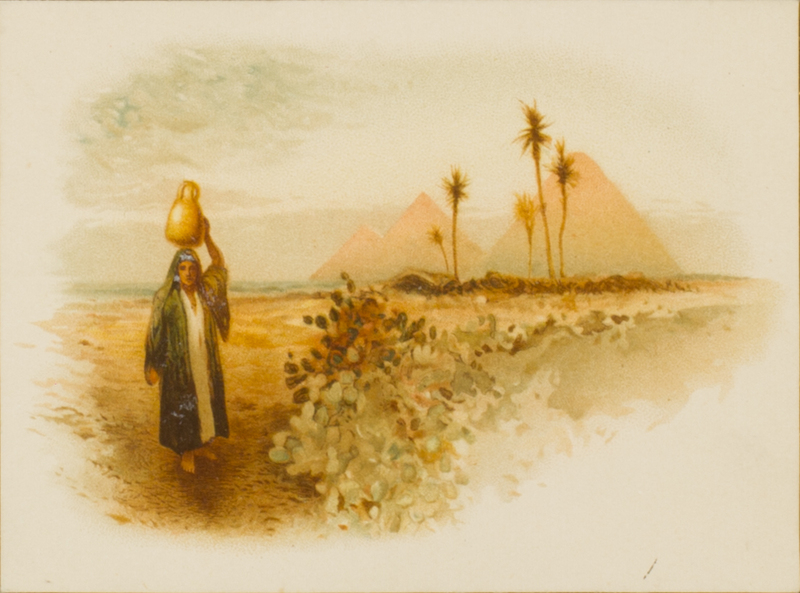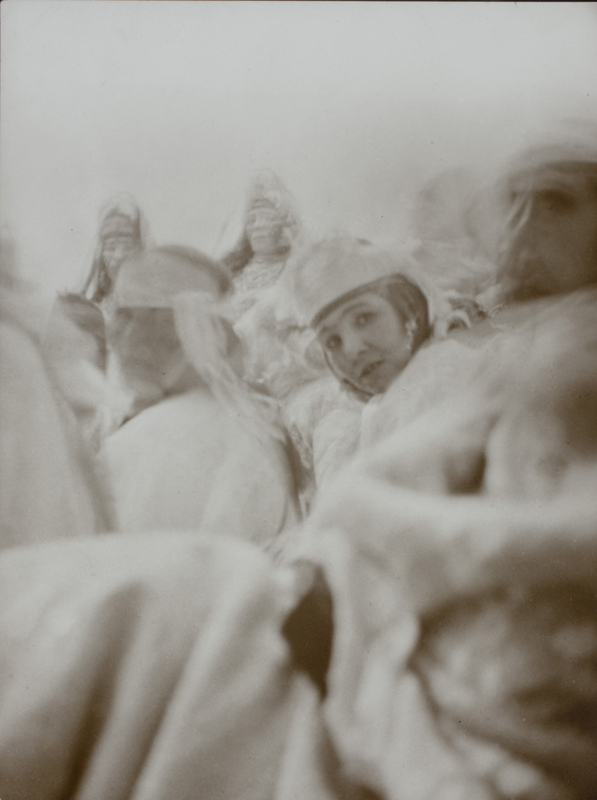Describing the Other: West and East
As Hiram Sibley’s youngest child, Emily Sibley Watson was born to privilege, and her letters and manuscript reflect the biases of her time and class. On shipboard on her way from New York to Gibraltar she observes Italian emigrants (“they chatter from morning till night sitting out in the sunshine, playing cards and Lotto and dancing the Tarantella in the evening”), and reflecting on Jewish passengers [perhaps encountered on other trips] writes that “There are lots of pleasant people on board and it is a great comfort to hear your own language spoken and not the language of the ‘Chews.’”
When describing the inhabitants of Morocco and Egypt, Emily Sibley Watson generally keeps the distance and observer’s stance of a tourist, “studying the natives.” On Christmas Day in Egypt, she writes that Mrs. Perkins gave J.G. Averell a “Christmas card, a photograph with the different types of faces that one sees here on it.” We can see Emily Sibley Watson describing people in terms of their religion or ethnicity (their “type”) in both the Camping in Morocco manuscript and her letters from Egypt. The Berbers who inhabited the Rif Mountains are described as “mountain bandits,” from whom a Moorish soldier, a “Moro-del-Rey,” was to protect the Watson’s caravan. In the Camping in Morocco manuscript, she differentiates between the ruling Moors and Arabs, the former often described as “dignified,” and the latter exhibiting more servile behavior. In describing Jews at a festival at the Jewish cemetery in Tetouan, Emily notes that many of the women were “handsome,” but the men were “less attractive.” When stuck on a sandbank on the Nile for two weeks, Emily describes “Arabs by the hundreds pushing & pulling & grunting & chattering trying to get us off but all in vain,” and later efforts “with a lot of natives which failed completely principally because the natives wouldn’t push.” The implied laziness is compared with “an almost Moslem fortitude and resignation” that the Watson-Perkins party is beginning to feel as they remain stuck on the sandbank for over two weeks.
An extended passage from the Egypt trip demonstrates this distanced view:
It is the most Oriental country I have ever seen. In Morocco the people themselves were if possible even more so, but the country itself was very like the Riviera or Southern California. But here are the beautiful palm groves, the yellow sand and sand bluffs, with such exquisite coloring, the little white towers and minarets, the sunsets with their wonderful after-glow, all like some rare painting of the East - only far more beautiful. I don't think I could ever tire of it all, nor of the picturesque life of the people. The veiled women filling their waterpots by the river or carrying their little bronze babies astride on their shoulders, the men with their long staffs looking as though they had just rolled out of a Bible picture book, the flocks of sheep and of goats, the donkeys, the buffalo and last and best of all the camels. It is all perfectly fascinating and I wish you were with us to see it all.
Modern readers may note a lack of sensitivity in the texts, an attitude of cultural superiority and privilege. On the second night of Camping in Morocco, the Watsons camp near a “Koubba,” or saint’s grave, too close for comfort for the Moors in the party. Emily records the Watson party’s victory: “The Moors, particularly the soldier, at first objected to camping so near the grave as they considered it a desecration, but they were finally won over by the promise of a sheep for a treat on the morrow. “ Similarly, on visiting the Jewish Synagogue in Tetouan, the Watsons fall in love with distinctive hanging lamps. Emily writes: “We were seized with a desire to possess one of these lamps if possible and our interpreter finally found one for us in the parlor of a rich Jew who was willing to part with it for a consideration. This was quite a triumph.”
In Tangier, Emily Sibley Watson has an opportunity to visit women in a harem, an event that was becoming popular for tourists in the late 19th century. Sarah Graham-Brown, in Images of Women: The Portrayal of Women in Photography of the Middle East 1860-1950 (New York: Columbia University Press, 1988, p. 77-78), writes that: "with neither common language nor comprehension of each other's cultures, these encounters could be almost comic in their air of mutual incomprehension."
Emily Sibley Watson's description of her visit confirms this analysis: "...we tried to talk—but as all they could speak besides their own language was a little Spanish we did not make very much progress. However they motioned to me to take off my gloves & show my rings which I did to their evident delight & then I showed them the “finder” in my Kodak which they also enjoyed."
Emily Sibley Watson's privileged stance as an Anglo-American tourist is notably seen in her decisions to photograph individuals and groups in spite of knowing that they would not want to be photographed, and in spite of cultural prohibitions against figurative images. In a letter from Tangier she documents two such examples, the first when visiting women in a harem: "I managed to take one picture when they were not noticing which I hope will come out, for when I asked if they would let me take one they said “no” very decidedly." She writes of visiting a female-only wedding celebration later that day: "Again I tried my Kodak but here they will not let you take them if they know it and you have to be very careful not to let them know. But, oh! I do hope they will come out. The old woman that let me in carelessly left the door a little ajar & Jimmie peeped in & you should have seen the commotion & hubbub that followed. I was rather unceremoniously told to leave and did so at once."
Nonetheless, Emily Sibley Watson’s descriptions of non-Western cultures are on the whole positive and reflect her friendly & cheerful attitude. Invited to visit a Jewish household in Tetouan, Emily writes “It was most entertaining and interesting and we were truly grateful to our kind hostess for inviting us to her supper.” At the end of the Camping in Morocco manuscript, she describes Zophallah as “our dear old Moro del Rey, of whom we had grown so fond;” likewise she writes toward the end of the Nile trip, “We have all grown very fond of the "Sesostris" and of the Captain and crew and shall be sorry to bid them ‘Goodbye.’”
Emily’s summary of the Egypt trip reflects her attitude: “we have come to the last days of our ‘Lotus eating’ and shall soon be back in the busy world of people and newspapers once more. It has been a charming winter and entirely different from any other journey we are likely to take. I know of no other that combines so many pleasant things. A charming luxurious life, a beautiful river and country, picturesque people, wonderful air, and such interesting sights to see and places to visit.” This would not be their last adventure in this region—their travels left them with an interest in returning, with future trips to Algeria and Palestine.


